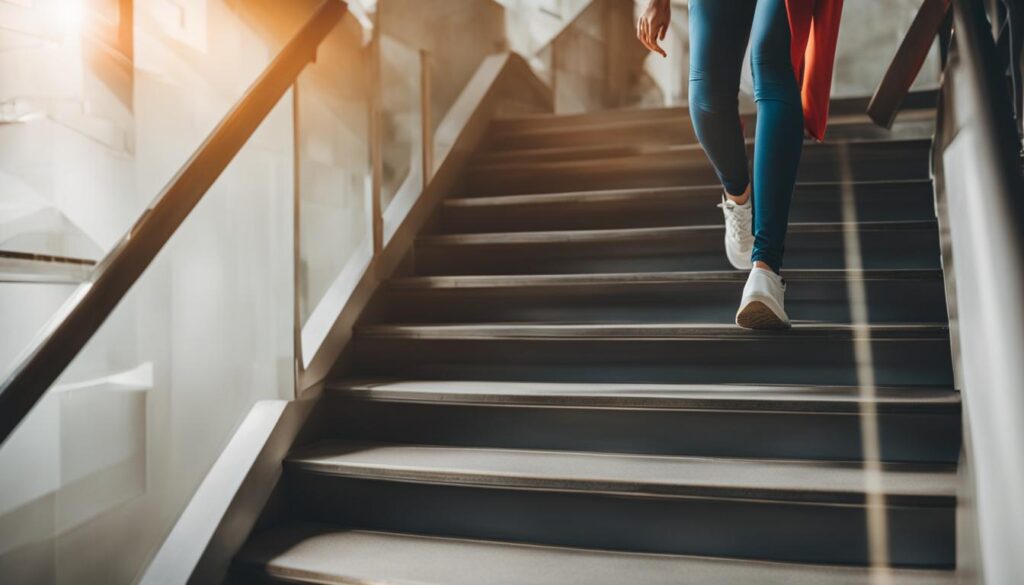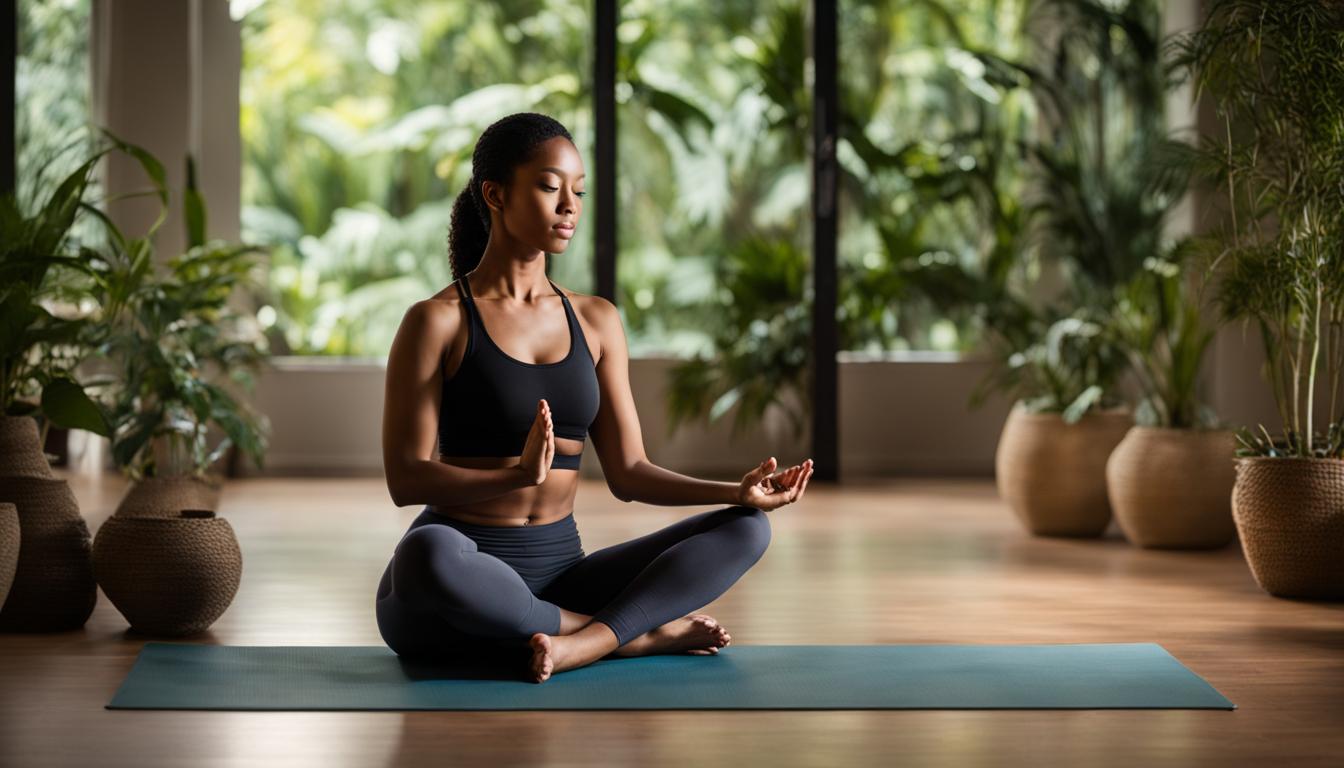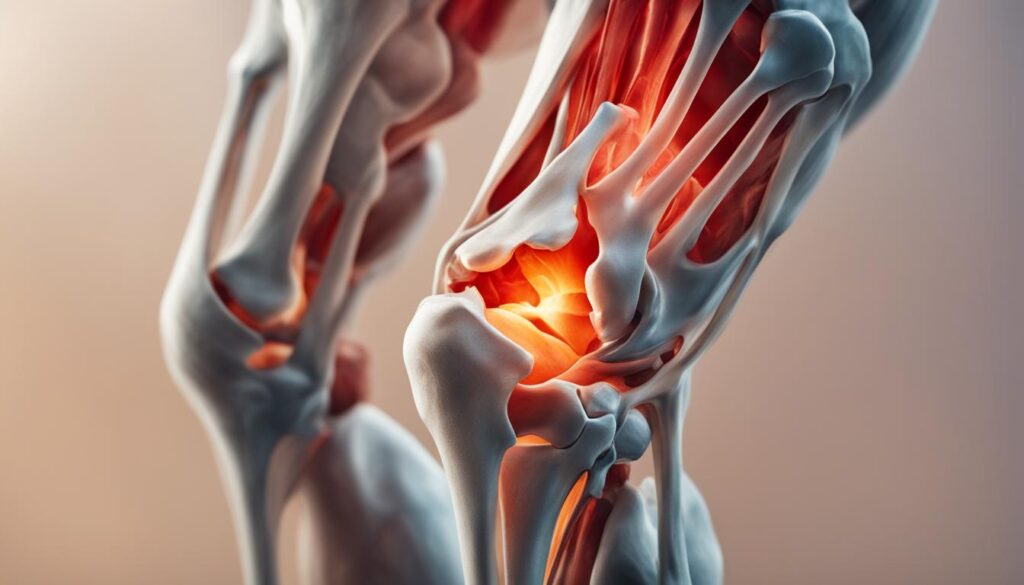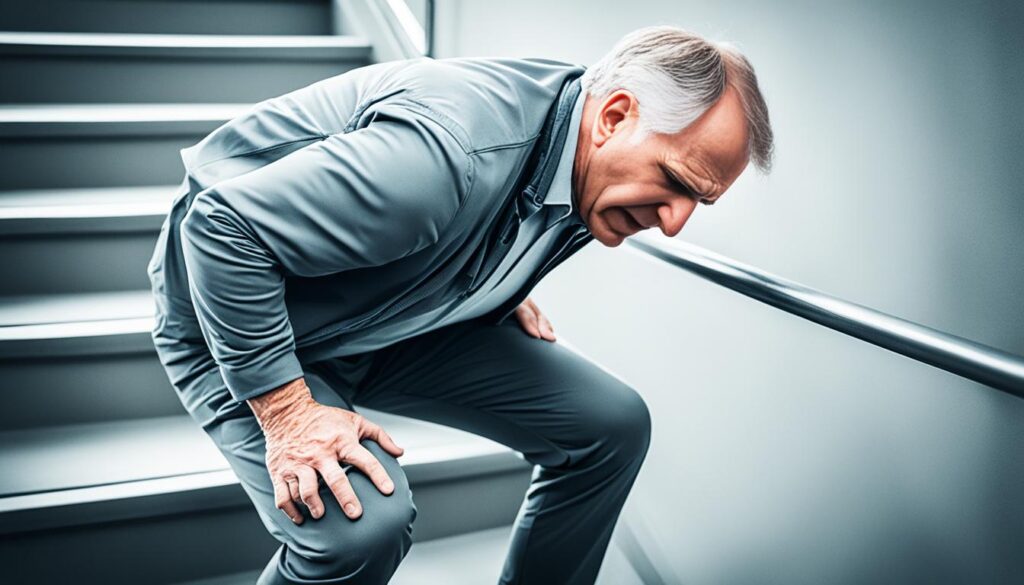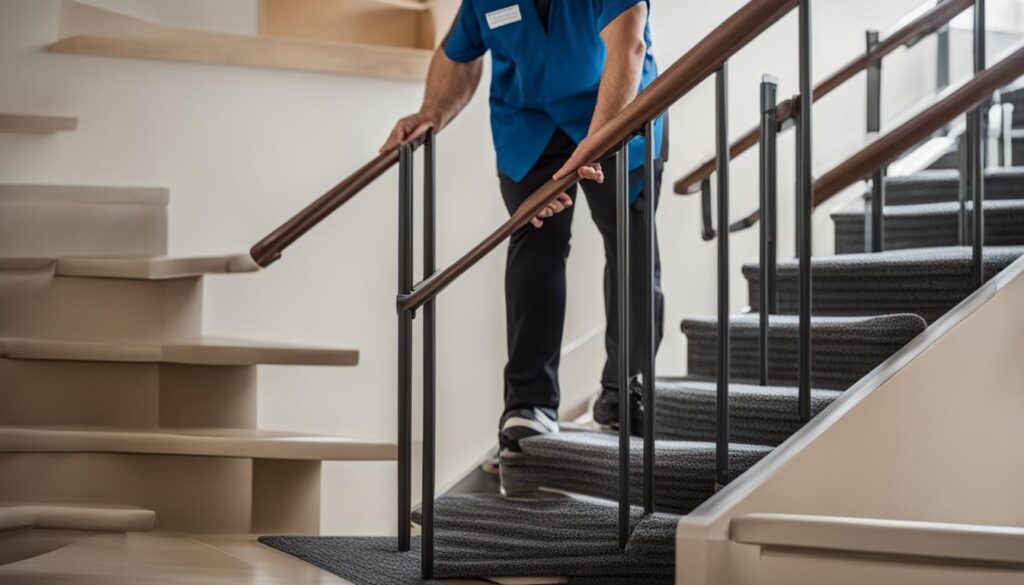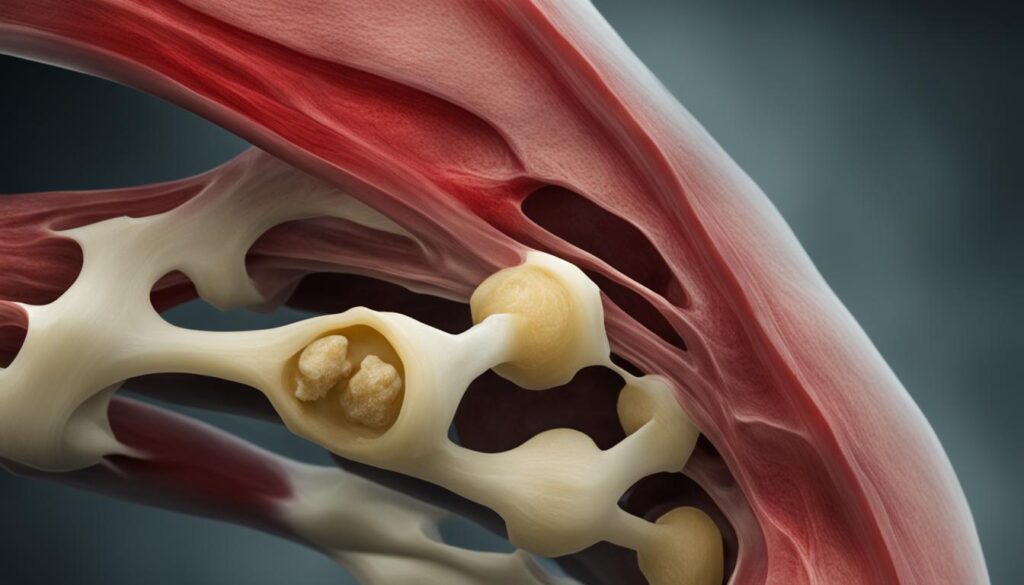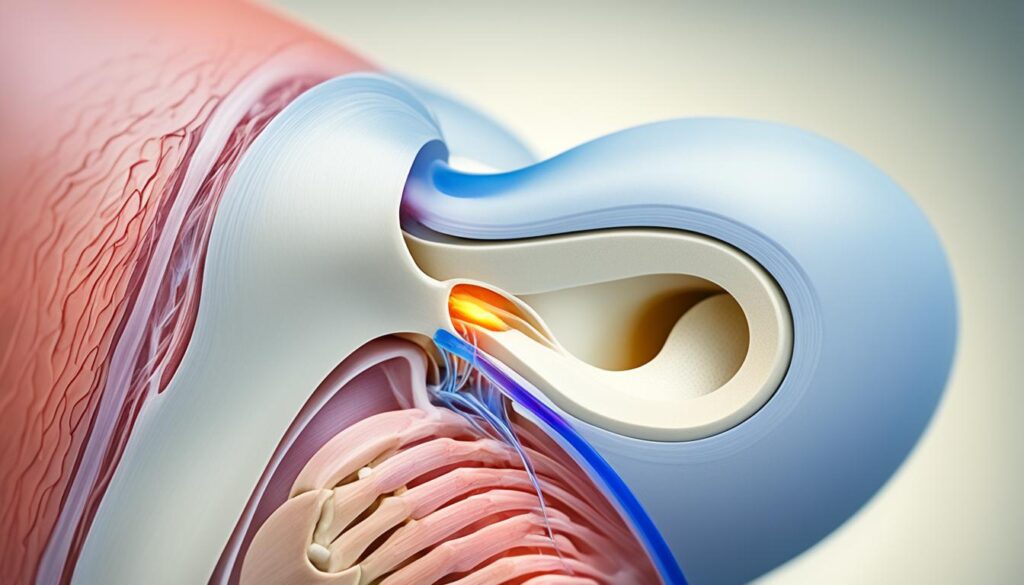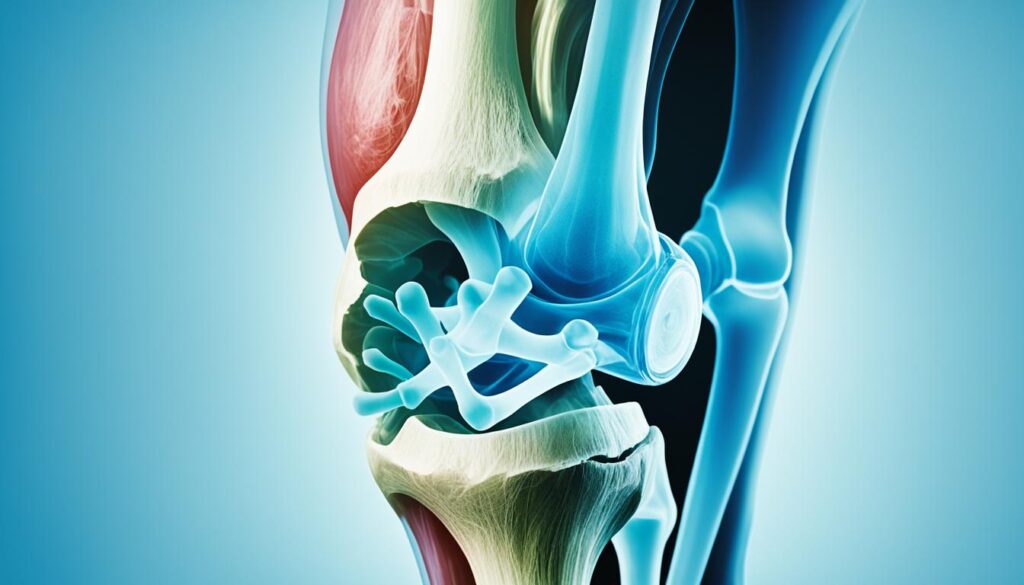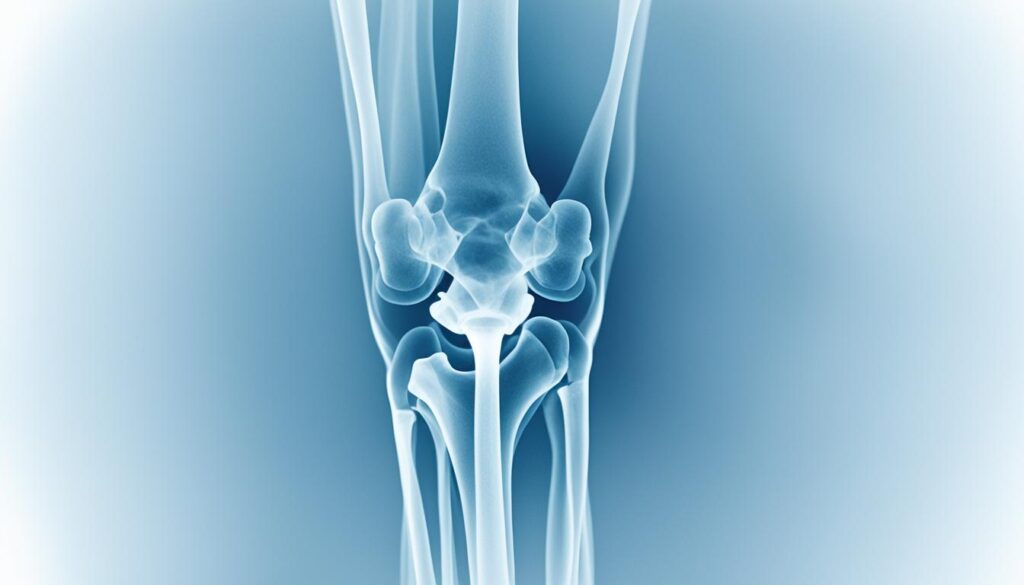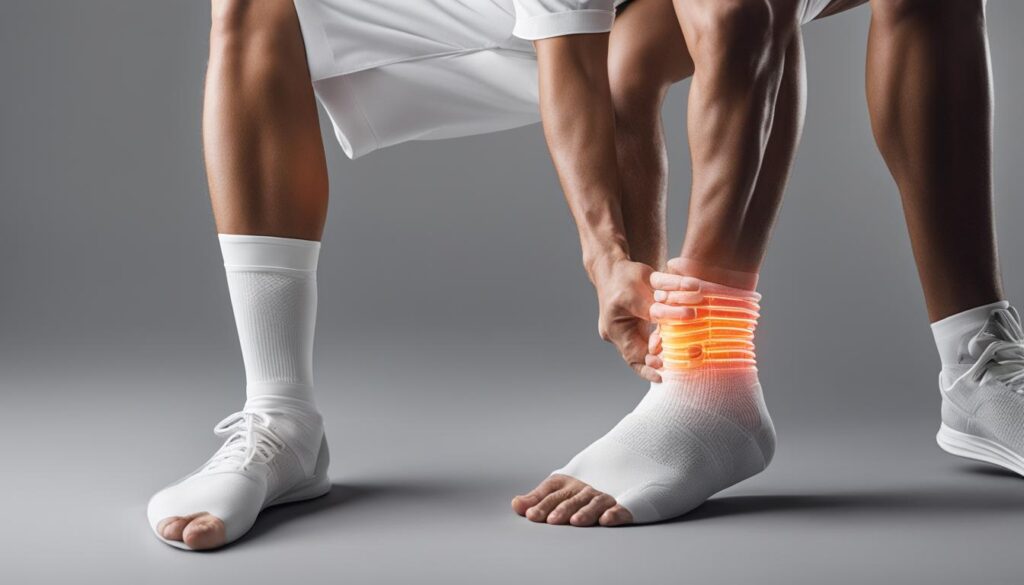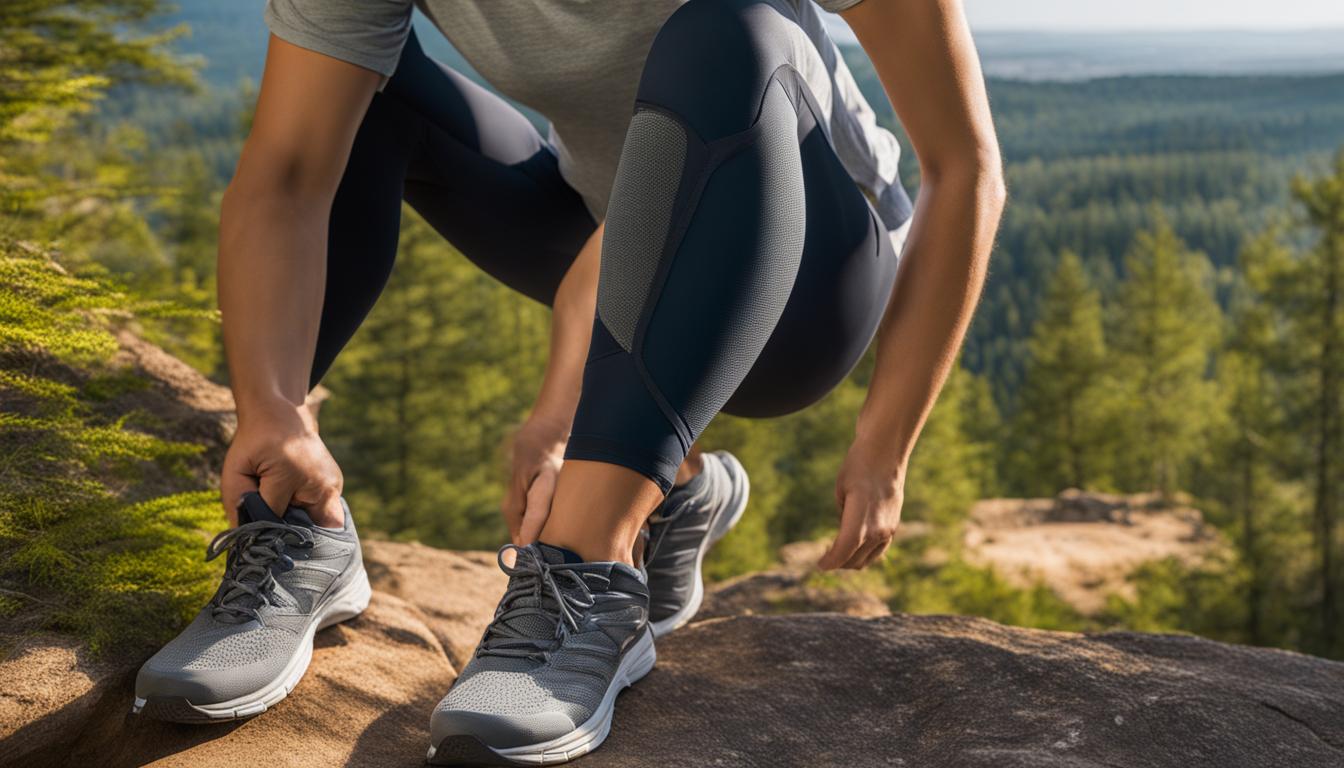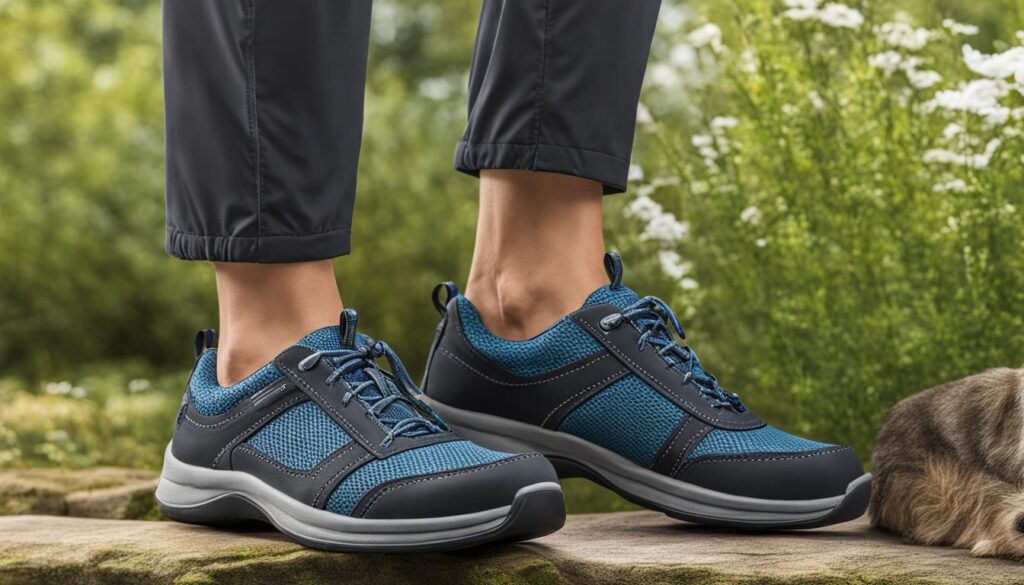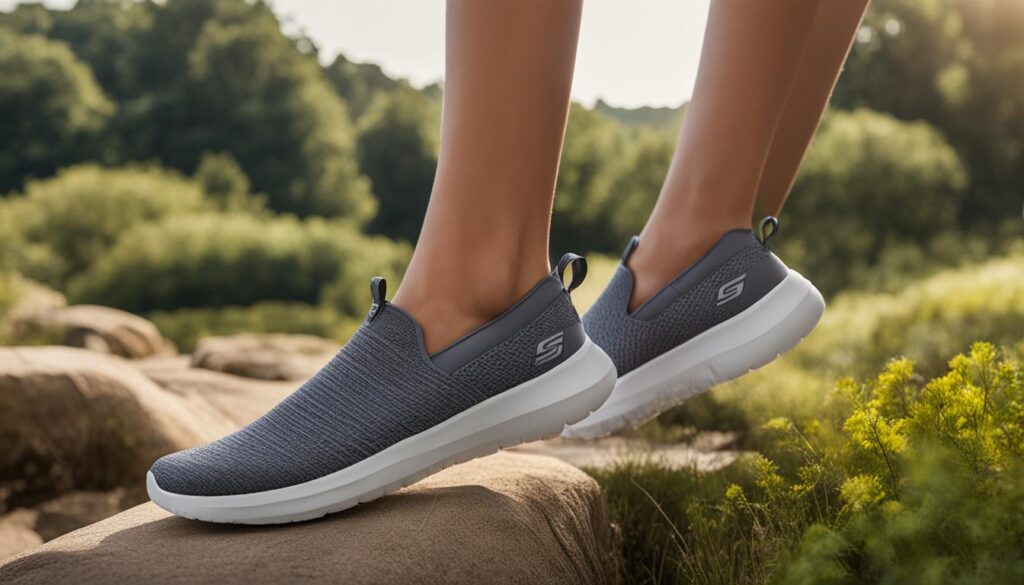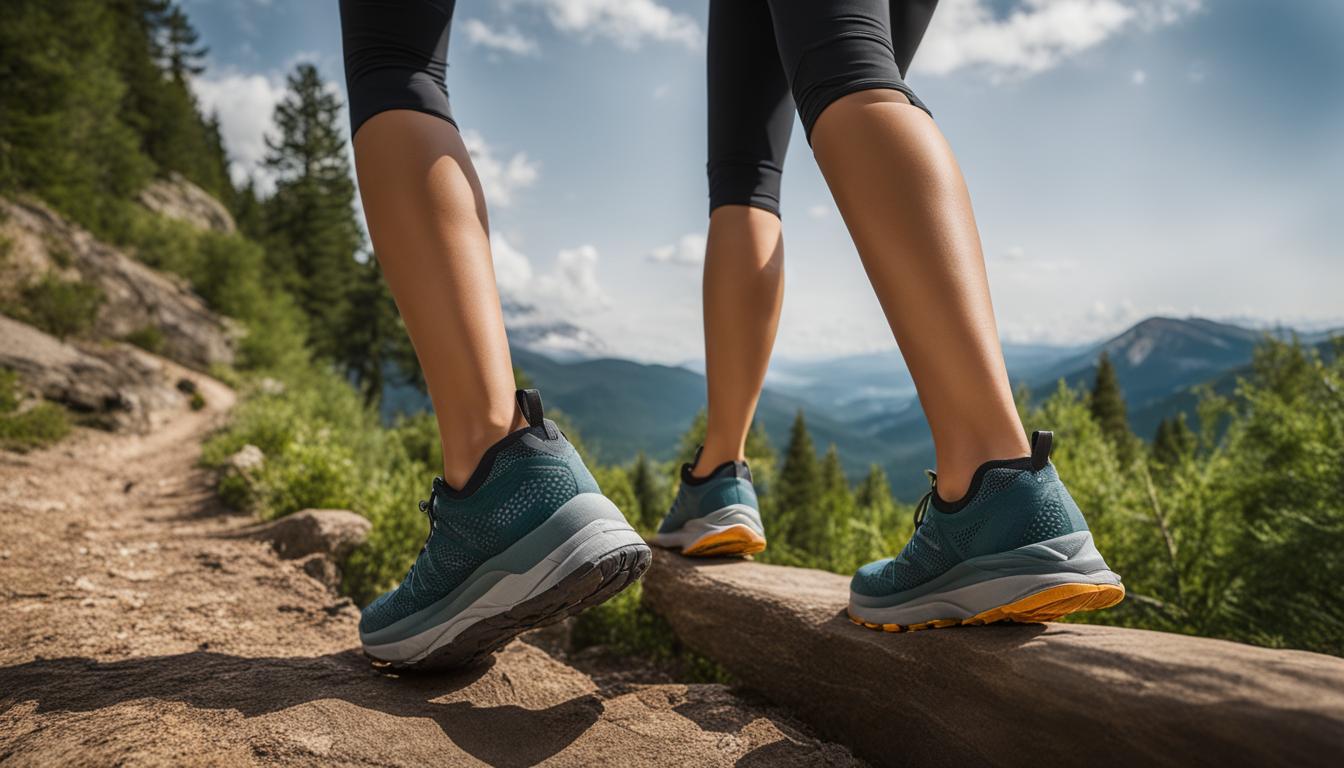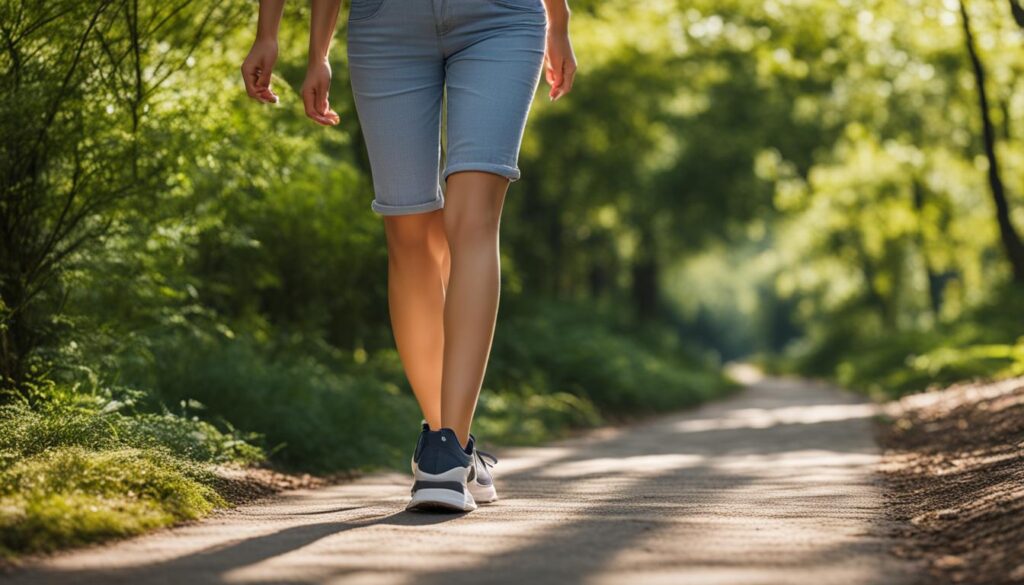Knee pain when going down stairs is a common problem that can significantly impact daily life. The force exerted on the knee cap when descending stairs is about 3.5 times the body weight, causing strain and discomfort. The main cause of knee pain when going downstairs is usually a problem with the knee cap and its movement. This can be due to various factors such as muscle tightness or weakness, flat feet, and abnormal anatomy. Common conditions that can lead to knee pain when going downstairs include patellofemoral pain syndrome (runner’s knee), chondromalacia patella, osteoarthritis, and pes anserine bursitis. It is important to seek appropriate treatment and follow exercises and strategies to reduce pain and improve knee function when dealing with knee pain on the stairs.
Key Takeaways:
- Pain at the front of the knee when going down stairs can be caused by issues with the knee cap and its movement.
- Common conditions that can lead to knee pain when descending stairs include patellofemoral pain syndrome, chondromalacia patella, osteoarthritis, and pes anserine bursitis.
- Exercises, muscle strengthening, and lifestyle modifications can help alleviate knee pain when going downstairs.
- Seek medical help if the pain is severe, persistent, or accompanied by swelling, instability, or difficulty walking.
- Understanding the forces on the knee when going down stairs can provide insights into why knee pain is more prominent during this activity.
Causes of Knee Pain When Going Down Stairs
Knee pain when going down stairs can be attributed to various underlying causes, many of which involve issues with the knee cap and its movement. Understanding these causes is essential in effectively managing and addressing the pain.
1. Patellofemoral Pain Syndrome (Runner’s Knee):
This condition occurs when there is a problem in the way the patella (knee cap) moves up and down. It is often associated with factors such as muscle tightness/weakness, abnormal anatomy, and flat feet. The misalignment of the patella can result in pain and discomfort, especially when descending stairs.
2. Chondromalacia Patella:
Chondromalacia patella is characterized by the breakdown and softening of the cartilage on the underside of the kneecap. When the thigh bone and knee rub together, it causes pain, particularly when going down stairs.
3. Osteoarthritis:
Osteoarthritis is a degenerative joint disease that commonly affects the knees. The gradual wear and tear of the joint’s cartilage can lead to pain, stiffness, and discomfort, particularly when descending stairs.
4. Pes Anserine Bursitis:
Pes anserine bursitis is the inflammation of the pes anserine bursa, which is located near the knee joint on the inner side of the knee. This condition can cause pain, especially when going down stairs.
Understanding these causes is the first step towards finding relief and effective treatment for knee pain when going down stairs. It is essential to consult a healthcare professional for a proper diagnosis and personalized treatment plan.

| Cause | Symptoms | Treatment |
|---|---|---|
| Patellofemoral Pain Syndrome | Pain around the kneecap, worsens when going downstairs | Physical therapy, exercises, orthotics |
| Chondromalacia Patella | Pain under the kneecap, worsens with knee bending and stairs | Rest, physical therapy, anti-inflammatory medication |
| Osteoarthritis | Pain, stiffness, swelling, decreased range of motion | Medication, physical therapy, weight management |
| Pes Anserine Bursitis | Pain on the inner side of the knee, worsens when going downstairs | Rest, physical therapy, corticosteroid injections |
Relief and Treatment for Knee Pain Going Down Stairs
For individuals experiencing knee pain when going down stairs, there are several strategies and treatments available to alleviate discomfort and improve overall knee function. These approaches focus on strengthening the muscles surrounding the knee, implementing personalized treatment plans, and making lifestyle modifications to manage pain effectively.
Strengthening Exercises:
One of the key ways to alleviate knee pain when descending stairs is by strengthening the muscles that support the knee joint. These include the quadriceps, hamstrings, hip adductors, gluteal muscles, and gastrocnemius. Engaging in targeted exercises that focus on these muscle groups can help improve knee stability and reduce pain. Consulting with a healthcare professional or physical therapist can provide guidance on suitable exercises and proper technique to avoid further strain or injury.
Stretching, Taping, and Bracing:
In addition to strengthening exercises, incorporating stretching techniques can be beneficial in managing knee pain when going down stairs. Stretching the muscles surrounding the knee, such as the quadriceps and hamstrings, can help improve flexibility and relieve tension. Some individuals may also find relief by using taping or bracing techniques that provide additional support to the knee joint during activities that involve stair descent. These can help reduce strain on the knee and alleviate discomfort.
Consultation with a Healthcare Professional:
It is essential to consult a healthcare professional for an accurate diagnosis and appropriate treatment plan. A healthcare provider, such as an orthopedic specialist or physical therapist, can assess the underlying cause of the knee pain and recommend suitable treatment options. They may also suggest nonsteroidal anti-inflammatory drugs (NSAIDs), such as aspirin or ibuprofen, for pain relief. Seeking professional guidance ensures that the treatment plan is tailored to individual needs and maximizes the chances of recovery.
Physical Therapy:
Physical therapy plays a crucial role in addressing knee pain when going down stairs. A physical therapist can develop a comprehensive treatment program that includes exercises to strengthen the knee and improve mobility. They may also incorporate other therapeutic techniques like manual therapy, ultrasound, or electrical stimulation to reduce pain and promote healing. Attending regular physical therapy sessions and following the therapist’s recommendations can significantly enhance the recovery process.
Lifestyle Modifications:
Implementing lifestyle modifications can have a positive impact on managing knee pain when descending stairs. Maintaining a healthy weight can help reduce the stress placed on the knees. Engaging in low-impact activities, such as swimming or cycling, can also be beneficial as they put less strain on the knee joint. Avoiding activities that exacerbate the pain, such as excessive stair climbing or high-impact exercises, can help prevent further discomfort. Additionally, using assistive devices such as handrails or stairlifts can provide support and reduce the impact on the knees, making stair navigation safer and less painful.
By following these relief and treatment strategies, individuals with knee pain when going down stairs can experience improved comfort, reduced pain, and enhanced quality of life. However, it is important to consult with a healthcare professional to determine the most suitable approach for their specific condition.

Tips for Navigating Stairs with Knee Pain
When dealing with knee pain, navigating stairs can be a challenging task. However, there are several techniques and tips that can help make going up and down stairs easier and less painful. Here are some strategies to consider:
- Lead with the whole foot: When stepping onto the stairs, try to lead with the whole foot rather than putting excessive pressure on the kneecap. This can help distribute the force more evenly and reduce strain on the knee.
- Activate the gluteus muscles: When going downstairs, focus on pushing off from the outer heel and activating the gluteus muscles. This can help take some of the strain off the knee and provide additional support.
- Use assistive devices: Consider using handrails or stairlifts to provide support and reduce the impact on the knees. These devices can make navigating stairs with knee pain much easier and safer.
- Take breaks and rest: If needed, take breaks and rest between going up or down stairs. This can help minimize strain on the knees and provide an opportunity for the muscles to recover.
By implementing these tips and techniques, you can make navigating stairs with knee pain a more manageable and less painful experience.
Understanding the Forces on the Knee when Going Down Stairs
When it comes to knee pain, understanding the forces exerted on the knee during different activities is crucial. This knowledge helps us comprehend why knee pain is more prominent when descending stairs. Let’s take a closer look at the impact on the knee when going down stairs and how it varies with different activities.
When we walk, the force exerted on the knee is approximately 0.5 times the body weight. However, climbing up stairs increases the force to about 2.5 times the body weight. The real challenge lies in going down stairs, where the force on the knee dramatically increases to about 3.5 times the body weight.
But wait, there’s more! Squatting, which exerts the highest force on the knee, can reach approximately 7-8 times the body weight. This significant variation in forces demonstrates why certain activities, such as descending stairs, can lead to more knee pain and discomfort.
| Activity | Force on the Knee |
|---|---|
| Walking | Approximately 0.5 times the body weight |
| Climbing up stairs | Approximately 2.5 times the body weight |
| Descending stairs | Approximately 3.5 times the body weight |
| Squatting | Approximately 7-8 times the body weight |
As we can see from the table, the forces on the knee progressively increase as the activity becomes more demanding. This information highlights the importance of protecting and supporting our knees during activities that involve higher forces, especially when descending stairs.
When to Seek Medical Help for Knee Pain on Stairs
Severe and persistent knee pain when going down stairs can be a cause for concern and may require medical attention. If your knee pain is interfering with your daily activities or if over-the-counter pain medications and home remedies are not providing relief, it is important to seek medical help. Additionally, if you experience any of the following signs along with knee pain when descending stairs, it is advisable to consult a healthcare professional:
- Swelling around the knee joint
- Instability or weakness in the knee
- Difficulty walking or bearing weight on the affected knee
A healthcare provider can accurately diagnose the underlying cause of your knee pain and recommend appropriate treatment options. This may include physical therapy to strengthen the muscles surrounding the knee, medication for pain relief, or further diagnostic tests such as X-rays or MRIs to evaluate the knee joint in more detail.
If you are unsure about whether to seek medical help for your knee pain, it is always better to err on the side of caution. Consulting a healthcare professional will not only provide you with a proper diagnosis but also ensure that you receive the appropriate treatment to alleviate your knee pain and improve your overall knee function.
Conclusion
Knee pain when going down stairs can be a frustrating and debilitating issue that significantly impacts our daily lives. The force exerted on the knee cap when descending stairs puts strain and discomfort on the knee joint. However, with the right approach, there are ways to find relief and improve knee function.
One of the key steps in managing knee pain when going down stairs is to strengthen the surrounding muscles. Exercises targeting the quadriceps, hamstrings, hip adductors, gluteal muscles, and gastrocnemius can help improve knee stability and reduce pain. Making lifestyle modifications, such as maintaining a healthy weight and avoiding activities that exacerbate the pain, can also play a significant role in alleviating knee discomfort.
Seeking medical help when necessary is crucial. Consulting a healthcare professional can lead to an accurate diagnosis and personalized treatment plan. Physical therapy, nonsteroidal anti-inflammatory drugs (NSAIDs), and other interventions may be recommended to address knee pain and improve mobility and function.
In conclusion, by understanding the causes of knee pain when going down stairs and implementing appropriate interventions, we can navigate stairs with greater ease and reduced discomfort. Don’t let knee pain limit your daily activities. Take proactive steps towards managing and improving knee health to enhance your overall quality of life.
FAQ
What causes knee pain when going down stairs?
Knee pain when going down stairs is usually caused by problems with the knee cap and its movement. Common conditions that can lead to knee pain when descending stairs include patellofemoral pain syndrome (runner’s knee), chondromalacia patella, osteoarthritis, and pes anserine bursitis.
How can I find relief and treatment for knee pain when going down stairs?
To find relief for knee pain when going down stairs, it is important to consult a healthcare professional for an accurate diagnosis and proper treatment. Treatment options may include strengthening exercises, physical therapy, medication, and lifestyle modifications.
Are there any tips for navigating stairs with knee pain?
Yes, there are several tips and techniques that can make navigating stairs with knee pain easier and less painful. Strategies such as leading with the whole foot, activating the gluteus muscles, and using assistive devices like handrails or stairlifts can help reduce strain on the knees.
What are the forces on the knee when going down stairs?
When going down stairs, the force exerted on the knee is about 3.5 times the body weight. This is significantly higher than the forces exerted during walking or climbing up stairs. Understanding these forces can help explain why knee pain is more prominent when descending stairs.
When should I seek medical help for knee pain on stairs?
It is advisable to seek medical help for knee pain on stairs if the pain is severe, persistent, or interfering with daily activities. If over-the-counter pain medications and home remedies do not provide relief, or if the knee pain is accompanied by other symptoms such as swelling, instability, or difficulty walking, it is important to consult a healthcare professional.



